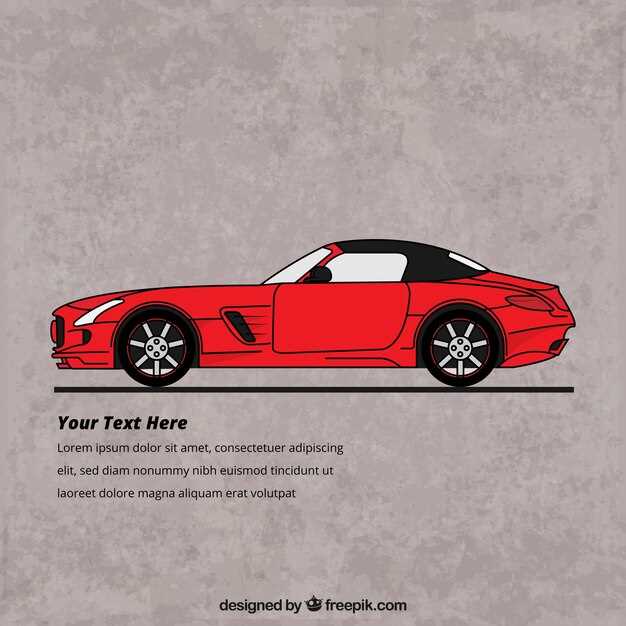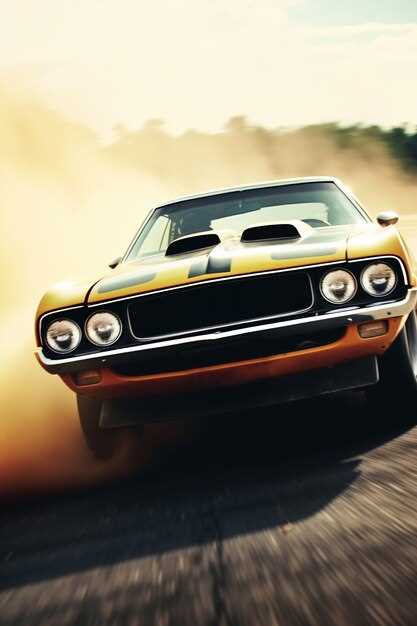If you’re deciding between a muscle car and a sports car, consider what drives your passion. Muscle cars offer raw power and often larger engines, focusing on straight-line performance. Think of iconic models like the Ford Mustang or Chevrolet Camaro, known for their robust V8 engines. They deliver thrilling acceleration and a nostalgic experience rooted in American automotive history.
On the other hand, sports cars, like the Porsche 911 or Mazda MX-5 Miata, prioritize agility and handling. These vehicles excel in curves and offer a more connected driving experience. They typically feature lighter frames and advanced technology to enhance performance, catering to those who seek precision on the track or winding roads.
Choosing between them often depends on your preferences regarding aesthetics, sound, and driving style. If you crave the roar of a powerful engine and classic styling, a muscle car likely fits your vision. Alternatively, if you prioritize nimbleness and a refined driving experience, a sports car will suit you better. Each category has its own unique charm, appealing to different automotive enthusiasts.
Muscle Cars vs Sports Cars: Understanding the Differences
Identify muscle cars and sports cars by their distinct characteristics. Muscle cars prioritize power and straight-line speed, while sports cars excel in agility and handling.
- Muscle Cars:
- Typically feature large V8 engines for high horsepower and torque.
- Emphasize a robust build with a focus on acceleration.
- Tend to have a more aggressive aesthetic, often appealing to nostalgia.
- Examples include the Ford Mustang, Chevrolet Camaro, and Dodge Charger.
- Sports Cars:
- Engine sizes vary but focus on lightweight construction and balance.
- Designed for sharp handling and responsiveness on curves.
- Offer a sleeker, more aerodynamic design, enhancing speed and efficiency.
- Examples include the Porsche 911, Mazda MX-5 Miata, and Ferrari F8.
Consider your driving preferences when choosing between these two types. If you enjoy raw power and straight-line performance, muscle cars might be the right fit. For those who appreciate cornering capability and precise handling, sports cars deliver an engaging experience.
Understand pricing and maintenance as well. Muscle cars generally have lower entry costs and may offer simpler maintenance due to traditional engine designs. Conversely, sports cars often come with higher price tags and can require more specialized care, reflecting their advanced engineering.
Test-drive both types to discover which aligns best with your driving style and preferences. Each category offers unique thrills, ensuring an enjoyable experience no matter your choice.
Defining Muscle Cars: Key Characteristics and Features
Muscle cars stand out for their powerful engines and distinctive design. These vehicles typically feature a V8 engine, which provides impressive horsepower and torque, delivering thrilling acceleration.
Another defining characteristic is the focus on straight-line speed. Muscle cars excel in drag racing scenarios, with performance metrics often emphasizing quarter-mile times over handling or cornering abilities.
Exterior styling plays a significant role. Bold lines, aggressive stances, and retro-inspired designs contribute to an unmistakable presence on the road. Manufacturers often incorporate wide bodies and distinctive hoods, enhancing their sporty appeal.
Interior features tend to prioritize driver engagement over luxury. Though some models include modern technology, the core focus remains on a driver-centric experience, often accompanied by a simplistic layout that emphasizes function.
Pricing for muscle cars can vary significantly, with options available for various budgets. Entry-level models offer incredible value while high-performance variants can demand premium prices.
Community and culture surround muscle cars, with a passionate following. Enthusiasts often gather for events, showcasing their vehicles and celebrating the muscle car heritage that dates back to the 1960s.
In summary, muscle cars combine raw power, eye-catching design, and a spirited community. They appeal to those seeking an exhilarating driving experience without the need for track-focused precision found in sports cars.
Defining Sports Cars: Key Characteristics and Features
Sports cars prioritize performance and driving experience over practicality. Look for a lightweight build, often utilizing materials like aluminum and carbon fiber, enhancing agility and speed. A powerful engine, typically a V6 or V8, drives these vehicles, delivering quick acceleration and high top speeds.
Handling distinguishes sports cars. Professionals tune the suspension for sharp cornering and stability, ensuring a responsive feel on both highways and winding roads. Rear-wheel drive is common, providing a dynamic and engaging driving experience, though some models feature all-wheel drive for enhanced traction.
Aerodynamics play a crucial role in design. Sleek shapes reduce drag and improve high-speed stability, while spoilers and diffusers enhance downforce, keeping the car grounded. Look for a low center of gravity, which contributes to better handling and cornering abilities.
Interior layouts focus on driver engagement. Bucket seats provide support during aggressive maneuvers, and controls are often driver-oriented for ease of access. Advanced technology enhances the experience, incorporating performance metrics, navigation, and entertainment systems tailored for enthusiasts.
Lastly, aesthetics matter. Striking designs and bold colors create visual appeal, often reflecting the brand’s heritage and performance capabilities. A sports car should evoke excitement just by looking at it, complementing the exhilarating driving experience it offers.
Performance Comparison: Speed, Handling, and Engine Power
When evaluating muscle cars versus sports cars, focus on speed, handling, and engine power. Muscle cars, like the Ford Mustang and Chevy Camaro, deliver impressive straight-line speed. With powerful V8 engines, they often achieve 0-60 mph in under 4 seconds, making them thrilling on highways and drag strips.
On the other hand, sports cars, such as the Porsche 911 and Mazda MX-5, excel in handling and agility. They typically feature lighter frames and advanced suspension systems, allowing sharp cornering and responsive steering. These cars may not always match muscle cars in raw acceleration, but their superior handling leads to exhilarating driving experiences on twisting roads.
Engine power is another significant aspect. Muscle cars emphasize high horsepower and torque, often reaching 400+ hp, which gives them a robust performance when accelerating. Sports cars, while powerful, often balance horsepower with lighter weight to enhance overall performance. Many sports models range from 250 to 500 hp, optimizing power-to-weight ratios for agility.
Consider the intended driving experience. Choose muscle cars for straight-line thrills and power, while sports cars offer precision in curves and daily driving comfort. Both types provide unique advantages depending on personal preferences in speed and handling dynamics.
Design and Aesthetic Differences: Style and Functionality
Muscle cars showcase bold and aggressive lines, highlighting their power and presence on the road. A wide stance, elongated hoods, and pronounced body shapes serve to emphasize raw performance. Brands like Chevrolet and Ford emphasize retro-inspired designs, which often resonate with a sense of nostalgia. These designs frequently feature elements like chrome accents and larger grilles, enhancing the muscular profile.
In contrast, sports cars pursue sleek, aerodynamic shapes that prioritize speed and agility. Manufacturers like Porsche and Ferrari focus on optimizing airflow, using curves and minimalistic designs to reduce drag. Lower profiles and wider rear ends contribute to a more dynamic stance, appealing to those who appreciate sophisticated aesthetics paired with performance.
Material choices also differ significantly between these categories. Muscle cars often utilize heavier materials, reinforcing their ruggedness and durability. Sports cars, on the other hand, frequently incorporate lightweight composites and aluminum to enhance speed and handling capabilities.
Interior designs reflect these distinctions as well. Muscle cars typically feature spacious cabins with classic touches like vinyl seats and retro-styled dashboards. Functionality takes center stage, with ample storage and comfort-focused layouts. Conversely, sports cars deliver a more driver-centric environment, prioritizing performance features like racing-inspired seats and advanced technological interfaces.
Color schemes further illustrate the contrast. Muscle cars often flaunt bold, eye-catching colors such as bright reds and yellows, evoking energy and excitement. Sports cars may lean toward subtler tones, like sleek blacks or silver, highlighting refinement and sophistication.
In summary, muscle cars embrace a loud, powerful aesthetic, reflecting their robust performance and American heritage. Sports cars, with their sleek and agile designs, cater to those seeking elegance alongside speed. Each car embodies a unique philosophy, making the choice between them as much about personal taste as it is about performance.
Cost Analysis: Price Ranges and Maintenance Expenses
Muscle cars typically range from $30,000 to $100,000, depending on the model and condition. For example, a new Ford Mustang can start around $30,000, while high-performance models like the Dodge Challenger Hellcat can reach over $70,000. On the other hand, sports cars generally have a higher entry price, often starting at $40,000 and going well beyond $200,000 for luxury brands like Porsche or Ferrari.
When considering maintenance costs, muscle cars often have lower expenses. Routine services, such as oil changes and tire rotations, tend to be more affordable, often falling between $300 and $800 annually. Parts for muscle cars are also easier to source, thanks to their popularity and simpler engineering.
Sports cars, while offering superior performance, can lead to significantly higher maintenance costs. Annual expenses can easily range from $1,000 to $3,000, depending on the brand. Brake pads, tires, and specialized fluid changes in sports cars can add up quickly due to the advanced technology and high-performance components.
Both categories benefit from insurance options, but sports cars typically attract higher premiums due to their performance capabilities and repair costs. Muscle cars often provide a more economical insurance rate, making them easier to budget for over time.
- Muscle Cars:
- Price Range: $30,000 – $100,000
- Annual Maintenance: $300 – $800
- Insurance: Generally lower premiums
- Sports Cars:
- Price Range: $40,000 – $200,000+
- Annual Maintenance: $1,000 – $3,000
- Insurance: Typically higher premiums
Evaluate your budget and priorities. If you prefer a balance of performance and manageable expenses, a muscle car may be the better choice. For thrill-seekers willing to invest more in both purchase and upkeep, a sports car offers unmatched driving excitement.
Cultural Impact: Community, Events, and Brand Loyalty
Engaging with muscle and sports car communities builds strong connections among enthusiasts. Attend local meetups, where sharing knowledge and appreciation for these vehicles creates lasting friendships. Online forums and social media groups also play crucial roles in fostering conversations and connecting like-minded individuals.
Participating in car shows and racing events showcases both types of vehicles. These events not only highlight the performance and aesthetic qualities of muscle and sports cars but also bring together diverse audiences. Here’s a quick comparison of popular events:
| Event Type | Muscle Cars | Sports Cars |
|---|---|---|
| Car Shows | Focus on classic restorations and custom builds. | Emphasis on performance specs and cutting-edge designs. |
| Drag Races | Popular events for showcasing raw horsepower. | Time trials highlight precision and speed. |
| Track Days | Less common, but growing interest for muscle car enthusiasts. | Well-established, allowing drivers to test limits. |
Brand loyalty forms a significant aspect of the car culture. When drivers align with a specific brand, they often become lifelong supporters. Companies like Ford, Chevrolet, and Dodge cultivate this loyalty through dedicated merchandise and exclusive community events. Collecting brand memorabilia or customization options allows enthusiasts to express their identities.
Consider joining local clubs devoted to specific brands. These communities provide opportunities to participate in exclusive events, build networks, and influence automotive innovation. Your passion for cars transcends mere ownership; it becomes a shared experience that enriches your life and connects you with others who share your enthusiasm.






